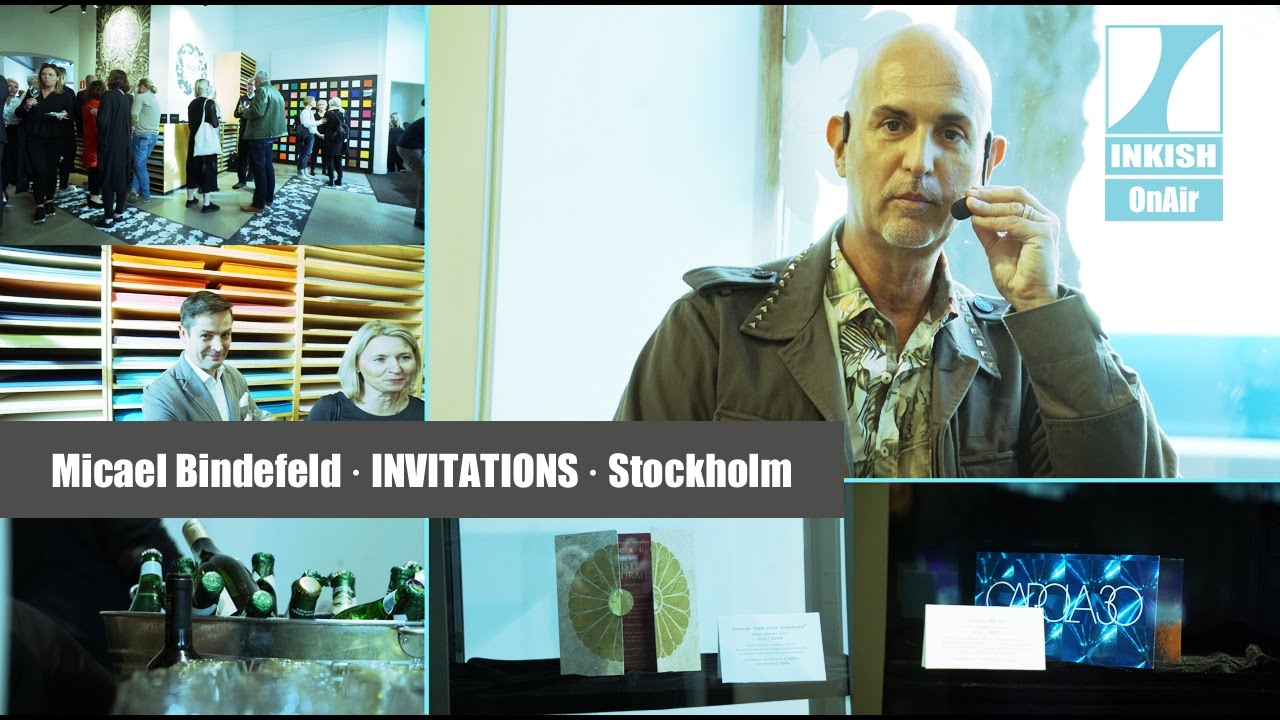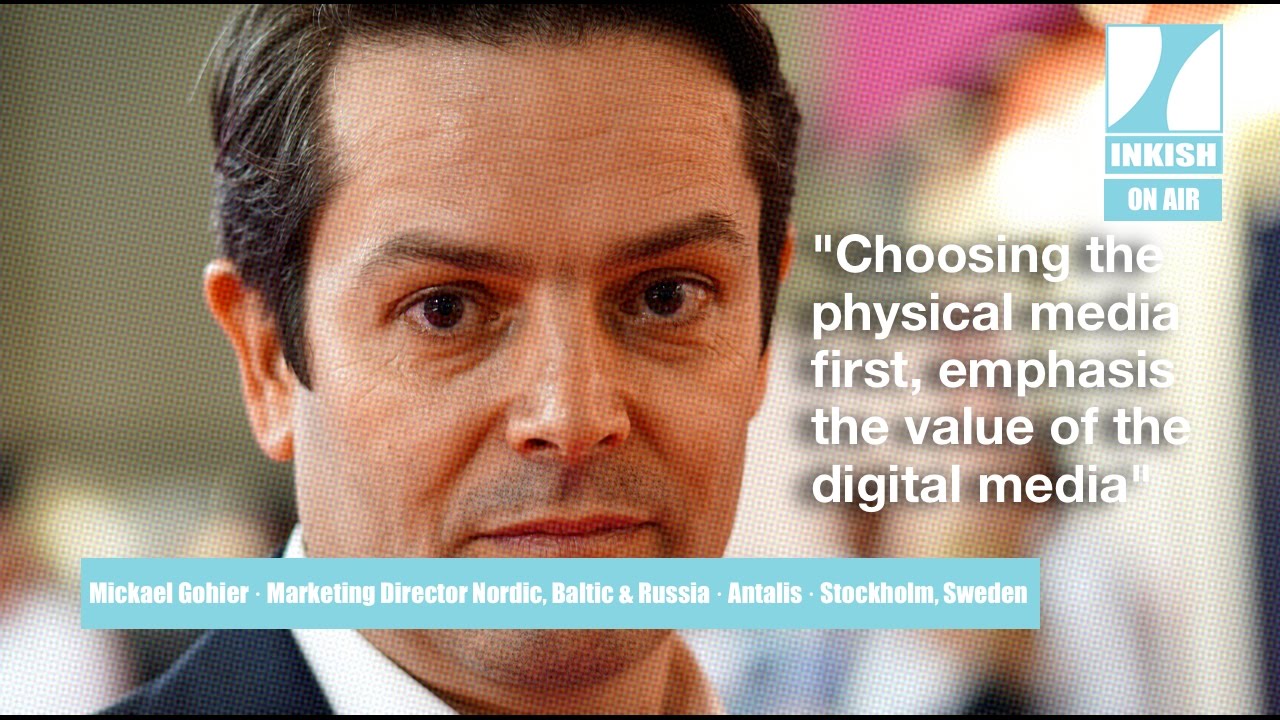INspiration · Micael Bindefeld · INVITATIONS · Stockholm, Sweden
INspiration is a new type of program from INKISH.TV where we will focus on things that can inspire the printing industry. In this first episode INKISH.TV was invited to Stockholm by paper merchant Antalis to not just see the exhibition by Micael Bindefeld but to literally experience it. Micael Bindefeld has for 30 years been a star among celebrities in Sweden – where he has arranged parties for politicians, actors, musicians and large companies. A centerpiece of his work is the more than 1.400 invitations that he has done. The selection he showcased at the event in the Antalis showroom was simply a stunning proof of what paper can do.
Watch this great and first episode in our new INspiration series – and as usual, stay tuned for more episodes in the nearby future.
0:01 This is about Micael Bindefeld, and his 30 years of work, being able to communicate and to really see to that that the invitations is something really special. And, he has been on TV today expressing the difference in between digital format and printed items. And, printed items is the master of that game, and communication is his area. He has picked 47 of his 1500 best invitations. And, you can see as well, we have had a lot of press, of course, and we have had a plenty of people yesterday coming, and today we expect at least about hundred to come.
0:50 Well, I’m known here in Sweden for organizing the grandest of events, and the most luxurious parties, the ones that everyone wants to be invited to, not only fashion and music, but also politics, and really grand things. The invitation cards are just the beginning of a long journey. So, when we take on an assignment, we sort of try to find a way of communicating the whole atmosphere of the party. So, the first sign of that is the invitation cards. They’re really important, and I’ve made my name with the invitation cards by trying to use odd materials, difficult ways of printing, challenge the printers in trying to do things that they thought were impossible.
1:46 The paper is very, very important when you do invitations. It’s the idea and the paper, and also in my case, the winners who are the lower rates, it’s very important too. As Micael Bindefeld, who is the party for? It’s very important to visualize it in the invitations.
2:10 And so when you’re here tonight, is it also to get inspiration from him or just to see around?
2:13 Actually, I’d just like to see. But, of course, I mean it’s a paper shop. You always get inspired by everything. So, I think it’s fun, lot of fun.
2:26 Paper has always been a part of ñ it sounds pretentious to say part of my life, but it really has. I was collecting paper for many years through my extensive travels through the world. Iíve been to paper factories in Laos, in Cambodia, in Burma, in North Korea, even on both papers that I used for an assignment, and Tibet. So, you know, I really like paper. Papers are sexy. Paper is recyclable. Paper is beautiful, and itís a beautiful way of communicating things with paper.
3:08 Paper is a combination. It appeals to your feelings, and to your senses, really. When you get a paper invitation for instance, itís more different than if you would receive it in digital form.
3:21 You know, for quite a few years, electronic invitations were cooler than having real invites mailed to you. I think now it’s gone the other way around. I think that you value as a receiver, as a guest, you value the work that the host or hostess has put into the invitation cards, and you feel that you’re actually picked, that you’re the one, and it sends a completely different signal.
3:57 I think when you have a card or a paper, this material when you have it in your hand, you can never make an invitation in the same way when you have it on a digital print. So therefore, I think that Antalis is on the market, and I think together we can promote these jobs and more.
4:18 And how do you do that in your job?
4:21 We are putting and showing a lot of material. We are showing printed examples together with a new persons, what we can find out to do together, and it’s all not only Antalis who makes the job, but when you find inspiration, people have a lot of ideas. We can help them together with the material we have. What can be perfect with that kind of end product?
4:44 Who is going to drive the need for the printed invitation? Is it the customers, the designers, or the printers?
4:49 I would say when it comes to specialties, it’s mostly the prescribers. They select something that they think is the right paper for that printed sample, and so mainly itís prescribers. They decide, and they also have more knowledge, I would say.
5:09 How is business?
5:11 Well, I would say, even though that the demand for paper is a decreasing market, you have an increase when it comes to specialties, because you have higher demands for special things. They’re not that many printers that really understands the importance of specials. Specials. That is where you can earn the money, and where you can make difference.
5:36 How do you think that the distribution will ñ Will that be a challenge in order to emphasize and describe that print is still a valid commodity or is that just another chance that we have to take on our shoppers?
5:50 Commodity paper will be a challenge, for sure, and we will not be able to serve the customers without them stepping in. For creative design paper, more added value paper, here, we believe that the value of the paper allows us to have express delivery services, even same-day delivery. So, we can even consider flight for some paper within Europe, acceptable from the printer and the consumer point of view, and printers are accepting it. They are actually pushing us to do it.
6:24 We have been talking to different designers, both on camera and off-camera. It seems that everybody here has a strong positive opinion that print is a very, very strong media in the future, as well.
6:38 It’s all about making sure we define good collaboration between the physical print media and the digital world. And, Antalis is definitely working on this concept more and more, but we try to make sure that the communication agency new-generation understand this concept, so this is why we have this exhibition.
7:03 So now, we have been talking to customers and colleagues, and to many different people here, and you have the honor to wrap it up. So, what is your opinion about today?
7:15 I think in some way, it was a success because we were able to raise the bar where we wanted it to be, in terms of inspiring the graphical industry, having somebody like Micael Bindefeld was, for sure a big help. And, as you said in your introduction, it’s closer to an art gallery than just printed sample realization. But, that’s actually where we want it to be, to make people remember that actually the physical media is very strong and very engaging with the consumer.
7:55 If you look at today’s event, we are focusing on agencies, bureaus and designers, marketing departments, and where they can get inspirations and have a look at the most beautiful communication tools, which Micael shows here this evening. So that I hope, inspires that part of the market, which is helping of course the graphical industry. That is what the showroom is all about.
8:25 Is this something you do on a returning basis or is this like a one time off?
8:29 It is something that we used to do, and it is something that we want to do more and more. And, we want to do it with the right people, so Micael Bindefeld is a good candidate for this kind of event. The idea going forward, in the second semester and in the year to come, is to develop this concept and have people moving in with exhibition of printed realized samples, which is, you know, inspiring for the agencies. We will also go more and more in the visual communication world, so the interior decoration, the word decoration, word declaration, because there is a demand on the retail market for this. Hotels, shops, and this is definitely where we can also enhance the communication, revive it, update on a regular basis. So, we are not just talking about small format paper, but also big format media.




































































